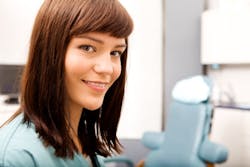Air polishing has changed—so why hasn't the dental hygiene curriculum?
I recall having a brief overview of air polishing and getting to use it in the clinic—just one time—when I was a student of dental hygiene back in 1993. At the time, I had mixed thoughts: "Wow! That stain came off like magic," "what a mess," and finally, "it's not worth the effort to assemble the unit, only to have my patient complain about how horrible it tastes."
In my 23 years as a hygienist working for countless dentists in Washington State and California, I've learned that only a small percentage of offices seem to have air polishing devices. I've given this very little thought over the years. When I did think about it, it was when patients with horrific stain landed in my chair. However, after attending a continuing education course earlier this year, taught by Karen Davis, RDH, BSDH, I started to give air polishing more thought.
Changes in air polishing
Air polishing was introduced in the late 1970s as an alternative to a rubber cup filled with pumice. (1) Using a slurry of water, abrasive powder, and pressurized air, the air polisher effectively removes extrinsic stain, plaque biofilm, and prepares occlusal surfaces of teeth for sealant placement. (1) Originally, air polishers were only intended for use on supragingival surfaces since the abrasive powder could potentially harm the softer tissues, such as the cementum, dentin, and gingival epithelium. (1)
Like many things in dentistry, air polishing has changed since the late 1970s. There are several new air polisher designs and new abrasive powders, and we now have the ability to use air polishers subgingivally. Sodium bicarbonate was the original abrasive powder used, but newer abrasive powders include glycine, calcium carbonate, calcium sodium phosphosilicate, aluminum trihydroxide, and erythritol. (2) These additional powders give us more choices for our patients' individual needs.
• Glycine is a naturally occurring amino acid that is finer, less abrasive, and water-soluble. (2) Glycine can be used subgingivally and has no salty taste. (2)
• Calcium carbonate is a powder that consists of spherical crystals for effective stain removal. (2) This may cause greater defects on root dentin and is not recommended for use subgingivally. (2)
• Calcium sodium phosphosilicate is a bioactive glass that helps occlude dentinal tubules to reduce sensitivity. (2)
• Aluminum trihydroxide is an alternative to sodium bicarbonate for patients who are on sodium-restricted diets, but it may be hard on some restorative materials. (2)
• Erythritol is a sugar alcohol that can help reduce periodontal pockets greater than 4 mm when it is mixed with 0.3% chlorhexidine. (2)
Patient selection
Patients must be selected carefully, as there are some contraindications for use. Typically, individuals with communicable disease, upper respiratory disease, compromised immune systems, sodium-restricted diets, polishing powder ingredient allergies, and contact lenses are not candidates for air polishing (3). However, sodium restriction is less of an issue now that there are powders without sodium.
Indications for use of an air polisher have typically included extrinsic stain removal, cleaning around orthodontic appliances, and to clean occlusal surfaces before placing a sealant. Now there are indications for use on exposed, hypersensitive dentin and periodontal pockets.
Benefits of air polishing
The benefits of air polishing for the dental professional include less operator fatigue, less time involved than the traditional polishing technique, and improved access to difficult-to-reach areas. Benefits to the patient include less time in the chair, less "scraping," excellent stain removal, reduced dentin hypersensitivity, and improved periodontal status.
Training regarding indications, contraindications, advantages and disadvantages is imperative for use of the air polisher. (1) When used by a properly trained clinician, the clinical benefits as well as patient safety increase. But today, as an educator, I consider dental hygiene curriculum and wonder why not much has changed in regard to training students to use air polishers. The air polishers themselves have evolved, the list of uses has increased, and yet, in many schools, our students are lucky if they learn how to use one.
Editor's Note: This article first appeared in Pearls for Your Practice: The Hygiene Product Navigator. Click here to subscribe. Click here to submit a products article for consideration.
References
1. Graumann SJ, Sensat ML, Stoltenberg JL. Air polishing: A review of current literature. J Dent Hyg. 2013;87(4):173–180.
2. Mohan R, Chowdhary Z, Sharma V. Air polishing: An update. Int J Maxillofac Res. 2015;1(1):22–34.
3. Henry R, Goldie M. Chapter 29: Polishing. In: Dental Hygiene: Applications to Clinical Practice. Philadelphia: F.A. Davis Co.; 2016.


